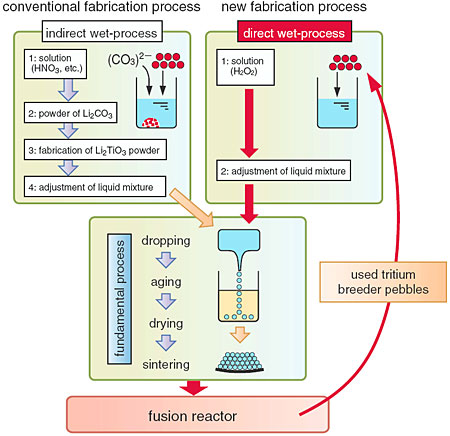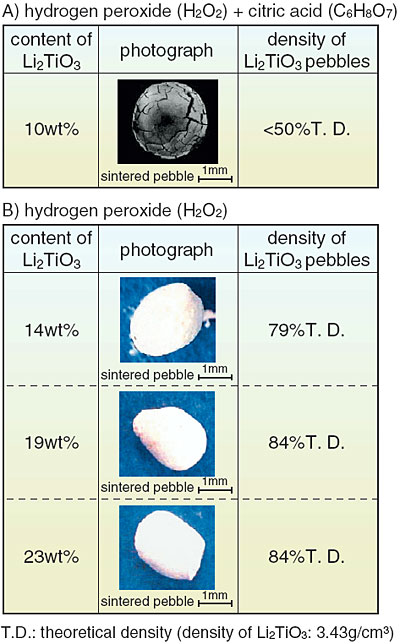In fusion reactors, tritium (T) breeder pebbles (lithium (Li) containing ceramics) for the production of T will be packed in the blanket. Lithium titanate (Li2TiO3) pebbles, composed of enriched lithium-6 (6Li), are proposed as a candidate T breeder. Previously an indirect wet process was used to fabricate Li2TiO3 pebbles. In this process, however, it is difficult to reprocess the used Li2TiO3 pebbles because of radioactivity. This process has many recycling preconditioning steps, a low Li recovery rate around 60%, and an abundance of wastes, so radioactivity is troubling. Therefore, development of an advanced fabrication process in which the used Li2TiO3 pebbles can be reprocessed was needed from the viewpoint of low cost mass fabrication, the recovery of the expensive 6Li, and also from the viewpoint of mitigating environment problems by decreasing radioactive wastes. With this background, a new fabrication process (a direct wet process) is proposed in which Li2TiO3 pebbles are fabricated by direct dissolution of the used pebbles (Fig. 11-3).
To understand this concept, the influence of the solvent on the properties of the fabricated Li2TiO3 pebbles was examined. At first, Li2TiO3 was dissolved by a solution of hydrogen peroxide (H2O2) and citric acid (C6H8O7), and a trial fabrication of Li2TiO3 pebbles was carried out using this solution. In the trial, the sintered pebble density was not high enough, and cracks formed on the surface of the pebbles because of gas released by the decomposition of the C6H8O7. Namely, the fabricated pebbles did not meet the design criteria (Fig. 11-4 A). In the next development trial, Li2TiO3 was dissolved in H2O2 only. By step-by-step heating, the Li2TiO3 dissolved satisfactorily in 30%-H2O2 (without C6H8O7 - which would result in gas release). Furthermore, the properties of Li2TiO3 pebbles were improved by modification of the content of Li2TiO3 in solution and the pebble drying process. Through these efforts, Li2TiO3 pebbles with about 80%T.D. (theoretical density) and without any cracks were successfully fabricated (Fig. 11-4 B).
Thus the fundamental process of the direct wet method has been established in which the used Li2TiO3 pebbles can be reprocessed.
|

